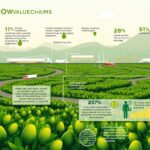CRISPR crops stand out as the go-to method for agricultural breakthroughs due to their incredible speed, precision, and adaptability. Scientists have already seen excellent results when using CRISPR on various plant species. Take, for instance, the team at Murdoch University who managed to cut down acrylamide in potato chips by up to 80%. Meanwhile, GreenVenus researchers are working on avocados that don’t turn brown, which could keep them fresh longer and cut down on food waste. What’s more, Pairwise has announced they’re starting field tests on the world’s first blackberries without seeds.
CRISPR agriculture has a big impact on the plant breeding market, which was worth $14.8 billion in 2023 and looks to grow 12.8% each year until 2032. We need to feed almost ten billion people by 2050, and CRISPR plants help by growing more, tasting better, and being kinder to the earth. New rules, like the USDA’s SECURE rule, have made it easier to grow CRISPR-edited crops that won’t harm other plants.
Study Shows CRISPR Doubles Yields in Key Crops
New scientific discoveries show that changing genes in farming can boost food growth. Scientists have made crops yield way more, which could help feed people worldwide.
Key findings from new peer-reviewed studies
A big study from Purdue University and the Chinese Academy of Sciences shows that CRISPR/Cas9 gene changes can create rice types with 25–31% higher grain yields. This giant jump would be almost impossible with old-school plant breeding. Furthermore, another key study proved that switching off certain genes in main grain crops boosted yields by 10% in corn and 8% in rice during real farm tests.
These findings have a big impact on CRISPR in plants, as even small percentage increases lead to big production gains. In fact, turning off just one gene out of tens of thousands in corn or rice genomes led to these impressive yield boosts. The results show a promising way to tackle the United Nations’ prediction that we’ll need to produce 60% more food by 2050.
Which crops showed the biggest yield increases?
Rice has shown the biggest yield gains through CRISPR agriculture. Tests in Shanghai, China, led to a 25% jump in grain output, while trials on China’s Hainan Island resulted in a 31% boost in yield. The increase could have an impact on global food security because rice provides about 20% of the calories people eat worldwide.
Maize (corn) has also improved, with genetic tweaks increasing yields by up to 10%. Since corn and rice account for over a third of the calories people consume , these improved yields could change food production a lot.
CRISPR technology has helped other crops too, including:
- Wheat – Scientists used targeted gene changes to create high-amylose wheat with better starch
- Tomato – CRISPR changes made tomatoes that grow fruit without seeds
- Barley – Changing ARE genes helped barley use nitrogen better, leading to more grain when less nitrogen was available
How researchers checked if crops grew more
The science teams checked these crop boosts through careful tests in real fields, not just in labs. For example, the rice varieties made at Purdue University went through field tests in two different places – Shanghai and Hainan Island. The results indicated that the rice grew more in different conditions.
Most studies took a step-by-step approach. They turned off or changed specific gene targets and then compared the new plants with normal ones in the same field conditions. For example, scientists focused on the PYL gene family in rice. This methodology let them measure how these genetic changes affected grain production.
CRISPR technology’s ability to edit multiple genes at once was helpful during testing. Scientists could change several genes at the same time. This method, which would take many years with old-school breeding, helped researchers test different gene combinations. They could then figure out which ones led to the biggest boost in crop yields.
The process to validate took several growing seasons and locations to make sure the noticed yield boosts were steady and could be repeated, not just because of favourable weather or growing conditions in one season.
Scientists Use CRISPR to Find Genes That Boost Yields
Researchers have found specific genes that, when targeted, lead to big jumps in yield using CRISPR tech. These exact changes focus on key biological processes that control how plants grow and produce.
Genes linked to making food from sunlight and taking in nutrients
CRISPR in plants has produced impressive outcomes by targeting genes that boost photosynthesis efficiency. Scientists at the Innovative Genomics Institute managed to increase the expression of the PsbS protein in rice crops, which improved photoprotective mechanisms and water-use efficiency. Furthermore, they employed CRISPR-Cas9 to alter the regulatory DNA upstream of PsbS, resulting in unexpectedly high expression levels for the research team.
Researchers at the University of Florida showed how CRISPR could boost light capture. They edited the LG1 gene in sugarcane, which affects leaf angle. This change cut the leaf inclination angle by 56%, which led to an 18% increase in yield. The new leaf position allowed the plants to catch more sunlight and turn it into biomass.
Nutrient uptake has emerged as another key focus. Researchers applied CRISPR-Cas9 to eliminate the OsHHO3 gene in rice, which acts as a transcriptional repressor of nitrogen transport. This change produced plants that showed better growth and more dry mass because of higher chlorophyll levels when nitrogen was scarce. A look at the transcriptome showed increased expression of the ammonium transporter (AMT) and nitrate transporter (NRT) genes, confirming the reason behind these gains.
Editing multiple targets at once for complex traits
Unlike old methods that change one gene at a time, CRISPR allows scientists to edit several targets. This ability to work on multiple genes has proven useful for complex traits that many genes control.
A team of scientists used a complicated sgRNA-CRISPR/Cas9 system to alter three genes that help rice resist diseases (Bsr-d1, Pi21, and ERF922) all at once. The plants they created showed better resistance to rice blast and bacterial blight. This resistance came from increased activity in salicylic acid and jasmonic acid pathways.
In fact new CRISPR systems now allow scientists to target up to seven genes in one go. For example, scientists at the VIB-UGent Centre showed success rates of over 70% when aiming for 4–7 changes at once. This ability has a big impact on plant genetics by making complex changes possible in just one generation.
How CRISPR beats old-school plant breeding
Old-school crop breeding takes 10 years to add just one top-notch gene version to commercial crops through mixing and remixing. CRISPR-Cas9, on the other hand, can do the same job in 1-2 generations.
This means what used to take decades now happens in months. Dr. Dhruv Patel-Tupper says, “We can use CRISPR-Cas9 to create changes in key crop genes and get the same big jumps as we would in traditional plant breeding methods, but we focus on a specific trait we want to improve and do it much quicker.”
Furthermore, CRISPR has an unmatched ability to make precise changes. Unlike traditional crosses that bring in unwanted genetic material (“linkage drag”), CRISPR changes can focus on specific target genes. One study showed how CRISPR made it possible to develop complex traits influenced by several genes without changing the genetic structure of high-quality plants.
CRISPR’s better performance stands out in polyploid crops like sugarcane, which has 40 copies of some genes. By targeting the LG1 gene, scientists could control how many copies they changed, creating plants with improved traits. Achieving this level of fine-tuning would be nearly impossible using standard breeding methods.
CRISPR agriculture has caused a revolution in crop improvement by offering both speed and precision. Dr Fredy Altpeter of the University of Florida sums up: “This work shows unique opportunities for the editing of polyploid crop genomes where researchers can fine-tune a specific trait.”
Scientists Boost Crop Productivity Without Transgenes
Farm scientists are tackling regulatory obstacles in crop enhancement through new transgene-free CRISPR methods. These techniques avoid adding foreign DNA while keeping the yield gains of gene editing.
Transgene-free editing and regulatory benefits
Rules for developing crops favour methods that don’t use transgenes, which makes editing without transgenes very useful for selling crops. Normal CRISPR methods often need to put foreign DNA into plant genomes, which raises worries about unintended effects and following regulations. Still, approaches without transgenes offer a way around these problems.
The USDA’s SECURE rule, which started in October 2021, states that many CRISPR changes “have a history of safe use when it comes to plant pest risk”. So, plants edited without foreign DNA face fewer rule-related obstacles. This difference matters a lot because feeding the world’s people, expected to reach 9.3 billion by 2050, will need a 60% boost in food production.
When it comes to regional differences, the US keeps a more relaxed regulatory environment for CRISPR crops, while the EU enforces tougher GMO rules. These regulatory differences have an impact on where new CRISPR varieties first show up in farm markets.
CRISPR RNPs and base editing in field trials
Researchers have come up with several ways to achieve editing without transgenes:
- Pre-made ribonucleoprotein (RNP) complexes shot straight into plant cells through particle bombardment
- Base editing tech that allows precise changes to nucleotides without introducing transgenes
- Programmed systems that cut out transgenes after editing is done
RNP-mediated editing has advantages like few off-target effects and low toxicity because it breaks down. RNP editing works better in some species than others, but it removes worries about permanent transgene insertion.
Field tests using these methods have worked well. For example, scientists got up to 19.3% editing success in pepper with LbCas12a. CRISPR RNPs have also worked in rice, wheat, and other crops to boost disease resistance and nutrition.

Case study: Transgene-free high-yield rice and wheat
A key example comes from University of California, Davis, scientists. They created disease-resistant rice by editing a “lesion mimic mutant” with CRISPR. People worried at first about lower yields, but the team made varieties without transgenes that showed high yields and fought off rice blast fungus. In small field tests, these plants yielded five times more than regular rice hurt by the fungus.
Scientists in Italy have also made a rice type that resists Pyricularia oryzae, the fungus that causes rice blast. This rice has no transgenes. They changed a risotto-friendly variety (Telemaco Ris8imo) by removing parts of three genes that make the plant more likely to get sick. They focused on the Pi21 gene.
For wheat, scientists showed a transgene-free editing method that had 43.8-61.9% success rates in creating plants without the CRISPR/Cas9 DNA construct. This technique allowed scientists to develop homozygous mutants with no noticeable transgenes right in the T0 generation, which sped up breeding schedules.
CRISPR Boosts Plant Toughness Against Stress and Disease
Besides increasing yields in ideal settings, CRISPR in plants is key to keeping productivity high during environmental challenges that pose a growing threat to global farming.
Better yields under drought and salty conditions
Gene editing in agriculture has brought about impressive drought-resistant crop types. In corn, CRISPR-edited ARGOS8 versions showed much higher grain production in dry conditions with little yield loss during regular growing periods. These altered plants did better in field tests even in dry seasons, giving farmers a workable answer to water shortages.
When it comes to salty soil, which affects more than 20% of farmland worldwide, scientists have come up with some cool fixes. A team from China used CRISPR to change the OsNF-YC5 gene in rice, making plants that can handle salt better. This change made the plants react more to abscisic acid, a key hormone for dealing with stress, which then boosted the work of protective CAT enzymes.
Scientists working on wheat had similar luck when they removed the TaHAG1 gene, creating plants that can tough out salty conditions. These breakthroughs could help farmers grow more food on land that’s getting saltier.
How fighting plant diseases can boost crop yields
CRISPR crops often show big yield gains when faced with common plant diseases. Scientists at UC Davis created rice plants that can fight off blast fungus. These plants grew five times more rice than normal plants when planted in areas with lots of disease. This resistance didn’t come with the usual downsides that traditional breeding methods often cause.
CRISPR technology doesn’t just help with direct plant diseases. It also tackles virus problems in different ways. Scientists have used Cas13 to find and break down RNA virus genes. The process stops the viruses from making copies of themselves inside plants.
Examples from tomato, maize, and sorghum
Tomato plants show wonderful flexibility after specific changes. Editing the SlMAPK3 gene with CRISPR has an impact on how plants deal with drought. Plants without this gene wilted and had more cell damage when water was scarce. On the flip side, using CRISPR to edit CPK28 and target APX2 made plants better at handling heat. This matters a lot as the world gets hotter due to climate change.
Maize does well because of its C4 method of making food. Scientists used CRISPR to make this process even better. They improved how the plant uses water. This technique helps keep crop yields up when there’s not enough water around.
Sorghum, a crop that can handle dry spells well on its own, has an even stronger defence against droughts. Scientists used CRISPR to boost its antioxidant systems. These changes make the plant better at dealing with the stress caused by tough growing conditions.
How CRISPR Crops Could Change Global Food Supply
To feed 10 billion people by 2050, we need smart solutions that go beyond lab results. CRISPR crops might help solve this problem in ways that don’t just focus on growing more food.
What This Means for Small Farmers and Developing Countries
Small farms, which make up most of the agriculture in many developing countries, can benefit a lot from CRISPR technology. At first, CIMMYT scientists saw that CRISPR-Cas9 could help small farmers tackle food security issues caused by climate change, pests, and diseases. In East Africa, scientists are using CRISPR to fight the lethal necrosis disease of maize. Scientists can stop this disease by creating genetic resistance in the plants.
Just as crucial, CRISPR technology influences “orphan crops” with huge untapped potential. These crops hold local importance but lack global research attention. CRISPR edits could lead to major improvements in these plants. For example, CRISPR research on cassava has eliminated viral loads in plants. This procedure protects a crop vital to millions of farmers’ livelihoods.
Potential to reduce land use and environmental impact
CRISPR crops offer big environmental perks beyond feeding more people. Farms cover about one-third of Earth’s land. Crops that capture more carbon could help fight climate change in a big way. Scientists think that boosting sorghum’s ability to photosynthesise could trap up to 1.4 billion metric tonnes of CO₂ each year.
Furthermore, CRISPR-edited crops need fewer pesticides and can grow in poor soil, which reduces the need to turn forests into farms. We can enhance the resource efficiency of these crops, contributing to food production while minimising environmental harm.
What experts think about growing and using these crops
Surveys of experts show most agree that CRISPR-edited crops can grow better, have higher quality, and handle climate change better—all of which help feed more people worldwide. But rules differ a lot in different countries. While the USDA has said many CRISPR crops don’t need strict rules, experts in Europe say EU rules discourage or stop the use of gene editing.
In the end, getting the public on board is key. So, scientists stress the need to gain the trust of people who’ll use these products, whether they’re farmers or shoppers.
Conclusion
This article shows that CRISPR technology has a giant impact on farming worldwide. Rice yields going up by 25–31% and corn by 10% aren’t just small steps forward. They represent significant advancements in combating future food shortages. These results, proven through tough field tests in all sorts of places, show that this tech is dependable and works well.
CRISPR accurately targets genes related to photosynthesis, nutrient uptake, and stress response pathways, resulting in crops that thrive even in tough conditions. It would take decades for traditional breeding methods to achieve what CRISPR does in months, which speeds up our ability to tackle new farming threats. The creation of transgene-free editing methods has also dealt with regulatory issues, paving the way for these breakthroughs to reach farmers’ fields.
However, some problems continue to occur. Rules differ around the world, which might slow down widespread use in some areas. How much people accept these new ideas also plays a big part in how fast they spread. Therefore, it is essential to have ongoing discussions with communities, communicate clearly about the benefits and safety measures, and develop well-thought-out rules in tandem with technical progress.
Above all, CRISPR agriculture has a crucial role in our shared goal to feed almost ten billion people by 2050 while cutting down on environmental damage. This technology’s power to boost crop yields, make resource use more effective, and help plants withstand climate-related pressures makes it a key part of sustainable farming systems. By developing and utilising these gene-editing methods, we now have an unprecedented opportunity to improve global food security and preserve our planet for future generations.
FAQs
Q1. How does CRISPR technology increase crop yields?
CRISPR technology influences crop yields through exact gene edits linked to plant growth, photosynthesis, and stress reactions. Rice crops with CRISPR changes have shown yield boosts of 25–31%, while maize crops have seen improvements of up to 10%.
Q2. What are the environmental benefits of CRISPR-edited crops?
CRISPR-edited crops can lower environmental impact by needing fewer pesticides, growing well in poor soil, and using resources more efficiently. Some edited crops also capture more carbon, which might help combat climate change.
Q3. How does CRISPR improve crop resilience to stress and disease?
CRISPR influences crop resilience by changing genes that control drought tolerance, salt resistance, and disease immunity. This procedure leads to plants that can keep up their productivity in tough environments and fight off common pathogens.
Q4. What advantages does CRISPR offer over traditional breeding methods?
CRISPR works better than traditional breeding methods in terms of speed and accuracy. It can do in months what used to take decades, let scientists change multiple genes at once, and make specific changes without adding unwanted genetic material.
Q5. How might CRISPR agriculture impact global food security?
CRISPR agriculture has the potential to boost global food security in several ways. It can help increase crop yields, make food more nutritious, and create plant varieties that can withstand climate change. This technology has the potential to significantly impact small farmers and enhance the performance of lesser-known “orphan crops,” which hold significant importance in developing countries. These advancements could lead to more food production and better nutrition worldwide.









































































































